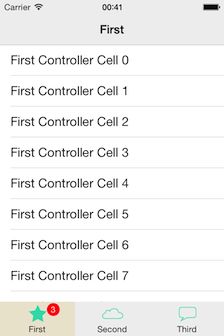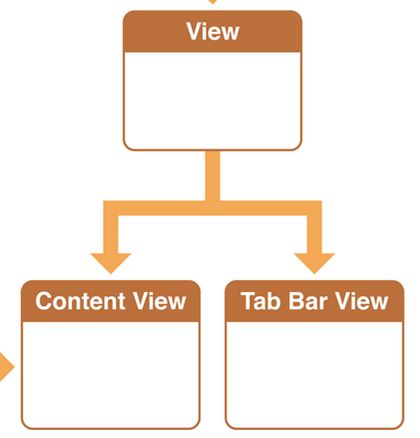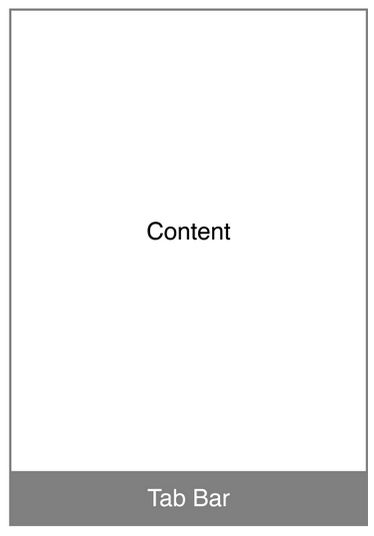RDVTabBarController 是一个定制化的TabBarController库,可动画显示隐藏tabbar栏,可定制tabbar栏,代码库地址在这,效果如下:
用法与UITarbarController差不多,一开始需要设置它的ViewControllers
RDVTabBarController *tabBarController = [[RDVTabBarController alloc] init];
[tabBarController setViewControllers:@[firstNavigationController, secondNavigationController, thirdNavigationController]];
具体的请看github上的介绍。
接下来看看,TabBar栏是怎么被添加到TarbarController的view上,为什么它能在每个ViewController上都能显示的。
首先,在RDVTabBarController类的viewDidLoad方法看到:
- (void)viewDidLoad {
[super viewDidLoad];
[self.view addSubview:[self contentView]];
[self.view addSubview:[self tabBar]];
}
注意添加顺序,先添加contentView,后添加tabBar,这样tabBar栏就不会被contentView覆盖挡住了。此时view的视图层级是这样的:
只要设置一下它们的大小和位置,也就能变成这样:
接着看viewWillAppear方法:
- (void)viewWillAppear:(BOOL)animated {
[super viewWillAppear:animated];
[self setSelectedIndex:[self selectedIndex]];
[self setTabBarHidden:self.isTabBarHidden animated:NO];
}
先看里面的setSelectedIndex方法:
- (void)setSelectedIndex:(NSUInteger)selectedIndex {
if (selectedIndex >= self.viewControllers.count) {
return;
}
//第一步
if ([self selectedViewController]) {
[[self selectedViewController] willMoveToParentViewController:nil]; //(1)
[[[self selectedViewController] view] removeFromSuperview]; //(2)
[[self selectedViewController] removeFromParentViewController]; //(3)
}
_selectedIndex = selectedIndex;
[[self tabBar] setSelectedItem:[[self tabBar] items][selectedIndex]];
//第二步
[self setSelectedViewController:[[self viewControllers] objectAtIndex:selectedIndex]];
[self addChildViewController:[self selectedViewController]];(1)
[[[self selectedViewController] view] setFrame:[[self contentView] bounds]];
[[self contentView] addSubview:[[self selectedViewController] view]];(2)
[[self selectedViewController] didMoveToParentViewController:self];(3)
[self setNeedsStatusBarAppearanceUpdate];
}
重点看,第一步,移除上一个所选的ViewController:
(1)willMoveToParentViewController方法,传nil参数表示子视图控制器将被移除;
(2)视图控制器的view从父视图中移除;
(3)子视图控制器从父视图控制器中移除,会自动调用didMoveToParentViewController方法来通知回调。
第二步,添加所选的ViewController:
(1)添加视图控制器,会自动调用willMoveToParentViewController方法;
(2)添加视图控制器的view;
(3)完成添加视图控制器,
要留意的是,是将ViewController的View添加到contentView中,而不是TabBarController的view。而以后push视图控制器的话,都是将视图控制器的view添加到contentView中,这样tabBar就始终能覆盖在contentView之上显示出来。
再看RDVTabBarController类中的setTabBarHidden方法:
- (void)setTabBarHidden:(BOOL)hidden animated:(BOOL)animated {
_tabBarHidden = hidden;
__weak RDVTabBarController *weakSelf = self;
//动画中执行的block
void (^block)() = ^{
CGSize viewSize = weakSelf.view.bounds.size;
CGFloat tabBarStartingY = viewSize.height;
CGFloat contentViewHeight = viewSize.height;
CGFloat tabBarHeight = CGRectGetHeight([[weakSelf tabBar] frame]);
if (!tabBarHeight) {
tabBarHeight = 49;//tabBar默认高度
}
if (!hidden) {
tabBarStartingY = viewSize.height - tabBarHeight;
if (![[weakSelf tabBar] isTranslucent]) {
contentViewHeight -= ([[weakSelf tabBar] minimumContentHeight] ?: tabBarHeight);
}
[[weakSelf tabBar] setHidden:NO];
}
[[weakSelf tabBar] setFrame:CGRectMake(0, tabBarStartingY, viewSize.width, tabBarHeight)];
[[weakSelf contentView] setFrame:CGRectMake(0, 0, viewSize.width, contentViewHeight)];
};
//动画完成的block
void (^completion)(BOOL) = ^(BOOL finished){
if (hidden) {
[[weakSelf tabBar] setHidden:YES];
}
};
if (animated) {
[UIView animateWithDuration:0.24 animations:block completion:completion]; //执行动画
} else {
block();
completion(YES);
}
}
这个方法是设置TabBar栏显示或隐藏,所使用的动画比较简单,动画中的block主要设置contentView和tabBar栏的大小和位置。而tabBar栏其实就是一个普通的view,通过设置它的hidden属性,就能让tabBar栏显示或隐藏。
其实,通过分析RDVTabBarController源码,也就明白如何自定义一个容器视图控制器了,同时也能大概明白UITabBarController内部的组织结构了。
最后,请看苹果官方文档:自定义视图控制器容器!


